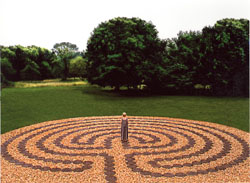Labyrinth: Difference between revisions
Pablo Sender (talk | contribs) No edit summary |
Pablo Sender (talk | contribs) No edit summary |
||
| Line 3: | Line 3: | ||
<br> | <br> | ||
<br> | <br> | ||
A '''Labyrinth''' (from the Greek λαβύρινθος labyrinthos) was in Greek mythology an elaborate structure designed and built to hold the Minotaur, a mythical creature that was half man and half bull. The Minotaur was killed by the Athenian hero Theseus who was able to escape with the aid of Ariadne, who provided him with a skein of thread. Scholars today distinguish between a maze (a multicursal puzzle with choices of path and direction) and a labyrinth (a single, non-branching path, which leads to the center). | |||
== Labyrinth at Olcott == | == Labyrinth at Olcott == | ||
[[File:Labyrinth at Olcott.jpg|300px|right]] | [[File:Labyrinth at Olcott.jpg|300px|right]] | ||
Behind the Rogers Building, on the west side of the campus, is a seven-circuit Cretan labyrinth. Composed of large stepping stones on a field of pebbles, the labyrinth symbolizes the seven aspects of the cosmos and the human being. Walking its winding path from the circumference to the center and back out again represents the involution and evolution of the universe, the birth and passing from life of an individual, and a quest to the center of our being and subsequent return to our divine source. Many visitors come to Olcott to walk the labyrinth throughout the daylight hours, when the grounds are open. | |||
<br> | <br> | ||
<br> | <br> | ||
| Line 12: | Line 15: | ||
<br> | <br> | ||
<br> | <br> | ||
== Online resources == | == Online resources == | ||
===Articles=== | ===Articles=== | ||
Revision as of 20:00, 1 February 2013

A Labyrinth (from the Greek λαβύρινθος labyrinthos) was in Greek mythology an elaborate structure designed and built to hold the Minotaur, a mythical creature that was half man and half bull. The Minotaur was killed by the Athenian hero Theseus who was able to escape with the aid of Ariadne, who provided him with a skein of thread. Scholars today distinguish between a maze (a multicursal puzzle with choices of path and direction) and a labyrinth (a single, non-branching path, which leads to the center).
Labyrinth at Olcott
Behind the Rogers Building, on the west side of the campus, is a seven-circuit Cretan labyrinth. Composed of large stepping stones on a field of pebbles, the labyrinth symbolizes the seven aspects of the cosmos and the human being. Walking its winding path from the circumference to the center and back out again represents the involution and evolution of the universe, the birth and passing from life of an individual, and a quest to the center of our being and subsequent return to our divine source. Many visitors come to Olcott to walk the labyrinth throughout the daylight hours, when the grounds are open.
Online resources
Articles
- The Labyrinth: A Brief Introduction to its History, Meaning and Use by John Algeo
- Going Around in Circles: The Labyrinths of Theosophy by Atala Dorothy Toy
